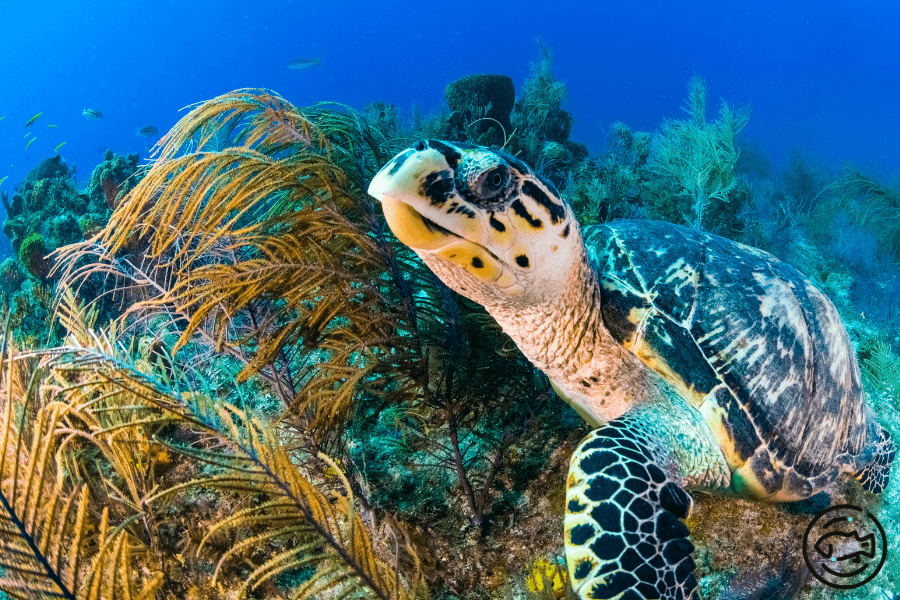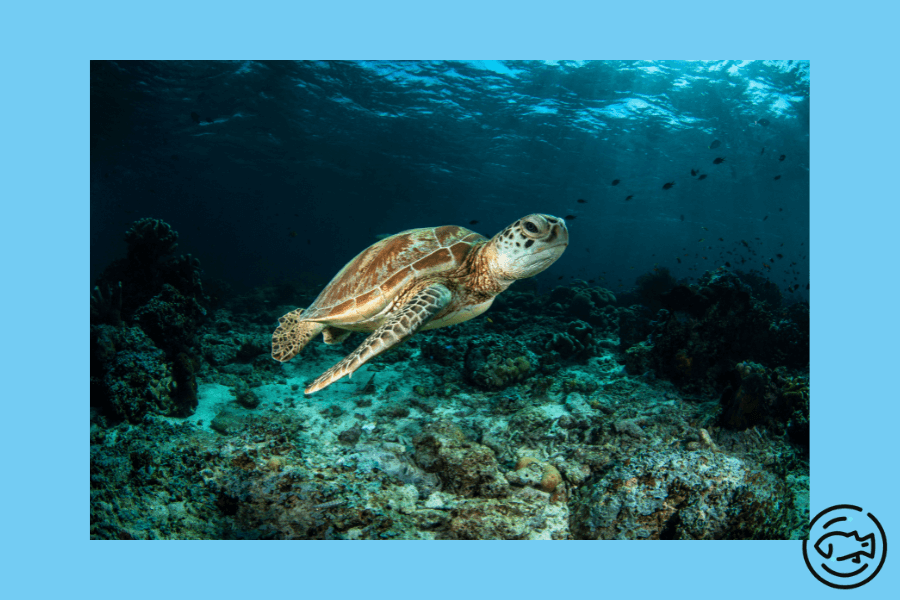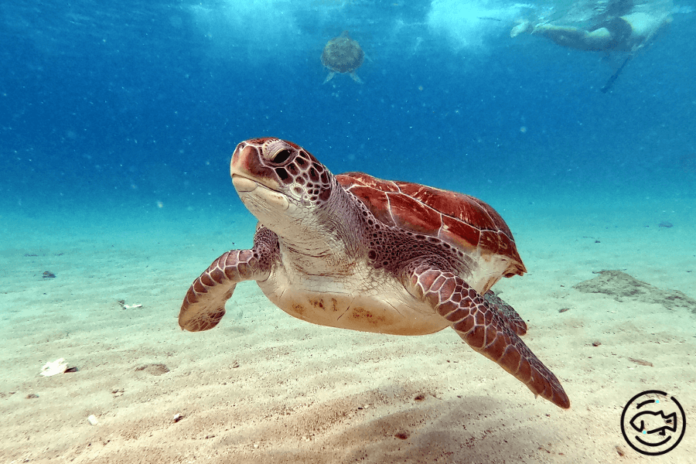Yes, they do, as while a single barnacle may not pose a significant threat to a turtle, an excessive amount of barnacles on a turtle’s shell can cause problems and hurt turtles. With their hard exteriors, the shells of turtles provide a suitable habitat for barnacles.
The problems that can occur due to excessive barnacles are reduced mobility, impaired vision, difficulty eating, and even the risk of infection.
It is essential to carefully monitor the number of barnacles on a turtle’s shell and address any overgrowth in order to maintain the turtle’s overall health and well-being.
In some cases, excessive barnacle growth can even influence a turtle’s capability to swim and dive, negatively affecting its ability to find food and shelter.
Understanding Barnacles & Why Do They Stick to Turtles?

Barnacles are small, aquatic invertebrates that are closely related to crabs and shrimp.
These creatures are typically pale or white in color and are often found attached to hard surfaces such as rocks and boat hulls in marine environments.
Barnacles are sensitive to cold or dry weather and require a certain level of moisture to survive.
As adults, barnacles are filter feeders, meaning they use their feathery appendages, known as cirri, to sift through the water and filter out small particles of food, such as plankton.
In their larval stage, barnacles secrete an adhesive substance that allows them to attach themselves to hard surfaces.
Once barnacles are affixed to a surface, they remain stationary for the remainder of their lives, relying on the movement of the water to bring them food.
It is worth noting that while barnacles may attach themselves to turtles, they are generally not harmful to the animals unless their shells become excessively covered with them, which can impede movement and cause other problems such as difficulty eating and impaired vision.
Do Barnacles Hurt Turtles?

Fortunately, most barnacles do not damage the turtles in any way and are not harmful. Having said this, if the turtle’s shell has been infested with barnacles, this does not mean that it is a good sign.
Healthy turtles can control the number of barnacles on their shells to keep them from getting innumerable. A turtle’s shell will be covered in barnacles if it is unhealthy.
It is, therefore, fatal for a turtle if its shell is overburdened with barnacles. The presence of excessive barnacles on the surface of a turtle usually indicates that it is inactive and lazy.
A turtle that is overgrown with barnacles will have difficulties moving at speed, and an overgrowth of barnacles will also cause distress to the turtle, as it cannot move at its regular speed.
Because of this, the turtle will have a harder time locating food because he will become more sluggish than usual. Due to its sluggishness, the turtle will be unable to catch its prey because it cannot move quickly.
As a result of the depredation and lack of food intake, in such cases, turtles are more likely to fall sick because they are undernourished.
Barnacles will also affect the turtle’s ability to swim due to their presence, and it will be difficult for turtles to swim if their shells are weighed down by additional weight.
This will make swimming more severe since the turtle has to drag itself, and it would have to exert more energy, resulting in exhaustion.
Moreover, a turtle’s vision will be impaired if the barnacles are stuck near its eyes.
Turtles are also negatively affected by barnacles attached to their mouths, as excessive barnacles prevent them from eating.
Getting drilled into the shell’s carapace will be the worst effect of barnacles. Infection from this can be severe and can present a serious threat to the turtle if not treated correctly.
It is easy for barnacles to attach to turtles, and they most often attach to sea turtles due to the saline conditions they thrive in.
Can sea turtles get rid of the barnacles on their shells in any way that can help them get rid of them?
also read: Can Turtles Climb Trees? – How, Why, & Which Ones?
Can Sea Turtles Remove Barnacles on Their Own?
Unfortunately, sea turtles do not have a specialized means of removing these attached barnacles. However, they may be able to knock off some of the barnacles with their flippers.
Additionally, some barnacles may fall off on their own if the turtle’s shell becomes damaged or scratched.
Female sea turtles may be able to shed some barnacles during mating season as they rub their shells against those of male turtles during sexual activity.
In contrast, male sea turtles may struggle to shed barnacles, which may only come off if the turtle’s shell is scraped against rough surfaces like rocks.
In more severe cases, proper treatment may be necessary to remove excess barnacles from a turtle’s shell as an excessive number of barnacles on a sea turtle’s shell can be harmful to their health, so it is essential to try and assist them in shedding these barnacles when possible.
Is It Possible to Remove Barnacles From a Turtle’s Shell?
There is no letting go of barnacles, as they are formidable creatures.
Turtles have a soft plastron and carapace, so forcibly removing barnacles can be very painful for them.
And the best thing to do is to consult a marine wildlife rehabilitation center so that specialized care can be given to a turtle that has barnacles hooked to its shell.
It is, therefore, risky to remove the barnacles with the force since this can cause damage to the turtle’s shell.
It is extremely necessary to carefully remove barnacles from the turtle’s shell when several barnacles have linked themselves to the shell.
A turtle’s shell can become heavily etched with barnacles, and trying to remove them could severely damage the turtle’s shell when attempting to remove it with extreme force.
In addition, when the barnacles are taken off the turtle’s surface, they leave a raw injury. If this wound is not treated with the appropriate medication, it may become infected. This situation can be more hazardous to the turtle’s health than the barnacles.
In the United States, it is necessary to obtain the correct permissions in order to remove barnacles. Failure to do so is considered a violation of the Endangered Species Act and a grave offense.
The removal of barnacles from a turtle’s shell can be carried out by specialized people in a wildlife center who must be very familiar with the procedure.
Turtles are placed in freshwater at the center, and this process prevents further barnacle growth & causes any existing algae to detach within the next 2 to 3 days.
Furthermore, putting the turtles in freshwater facilitates the removal of the barnacles. In addition, the facility staff also conducts a blood test to check for any other negative effects.
Through appropriate care and treatment, most of the turtles can fully heal within a couple of weeks and then are released back into the ocean.
Barnacle Infestation: A Danger to Turtle Health?
A barnacle is not life-threatening for turtles, so they rarely kill them.
An infestation of barnacles on a turtle’s shell may be a cause for concern, and a single barnacle does not harm the turtle in any way.
The overload of barnacles in such cases makes swimming and moving around difficult for turtles.
Furthermore, turtles have difficulties eating when they have a lot of barnacles attached to their mouths.
A turtle’s shell can be eroded by barnacles, and if that happens, the turtle is affected severely.
Turtles can get sick from starvation or infection if their barnacles are too dense.
Conclusion
So, Do Barnacles Hurt Turtles?
Yes, they do if they are attached to them in an excessive amount.
The barnacles that attach themselves to turtles are a common occurrence in the ocean.
There are barnacles on the turtle’s shell as they are permanently attached to it due to the fact that they spend their whole lives in the sea.
While a few barnacles on a turtle’s shell are not harmful, excessive barnacles can be dangerous to the turtle’s health and well-being.
If you encounter a sea turtle with many barnacles, it is important not to try to remove them yourself, as it could harm the turtle.
Instead, it is best to contact a wildlife rehabilitation center with the expertise to care for the turtle properly.


